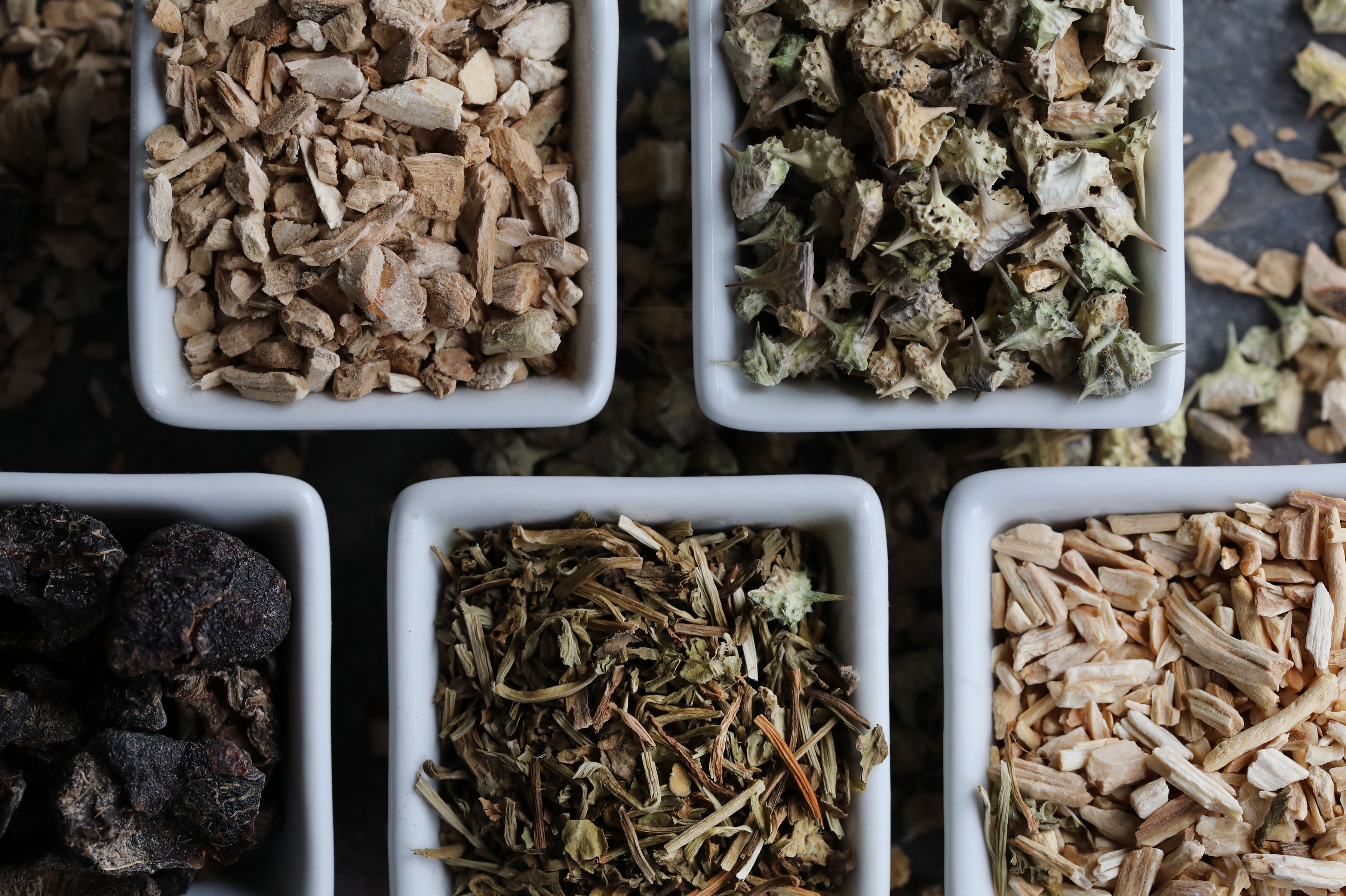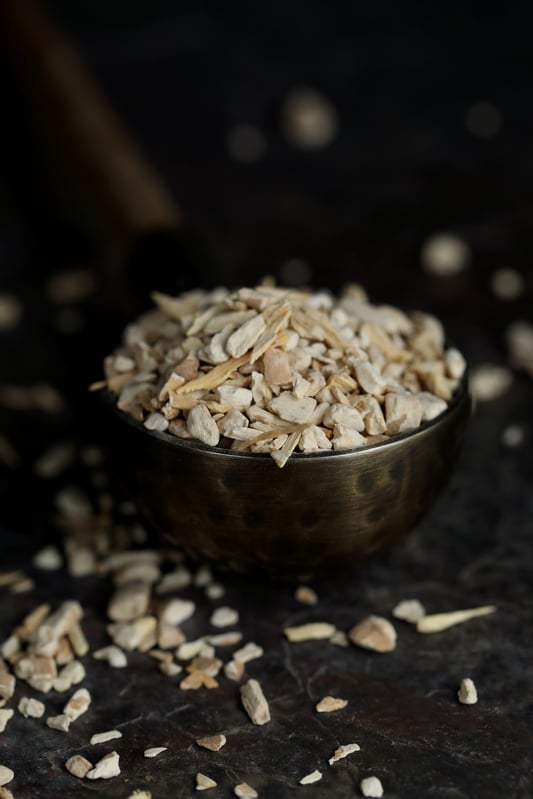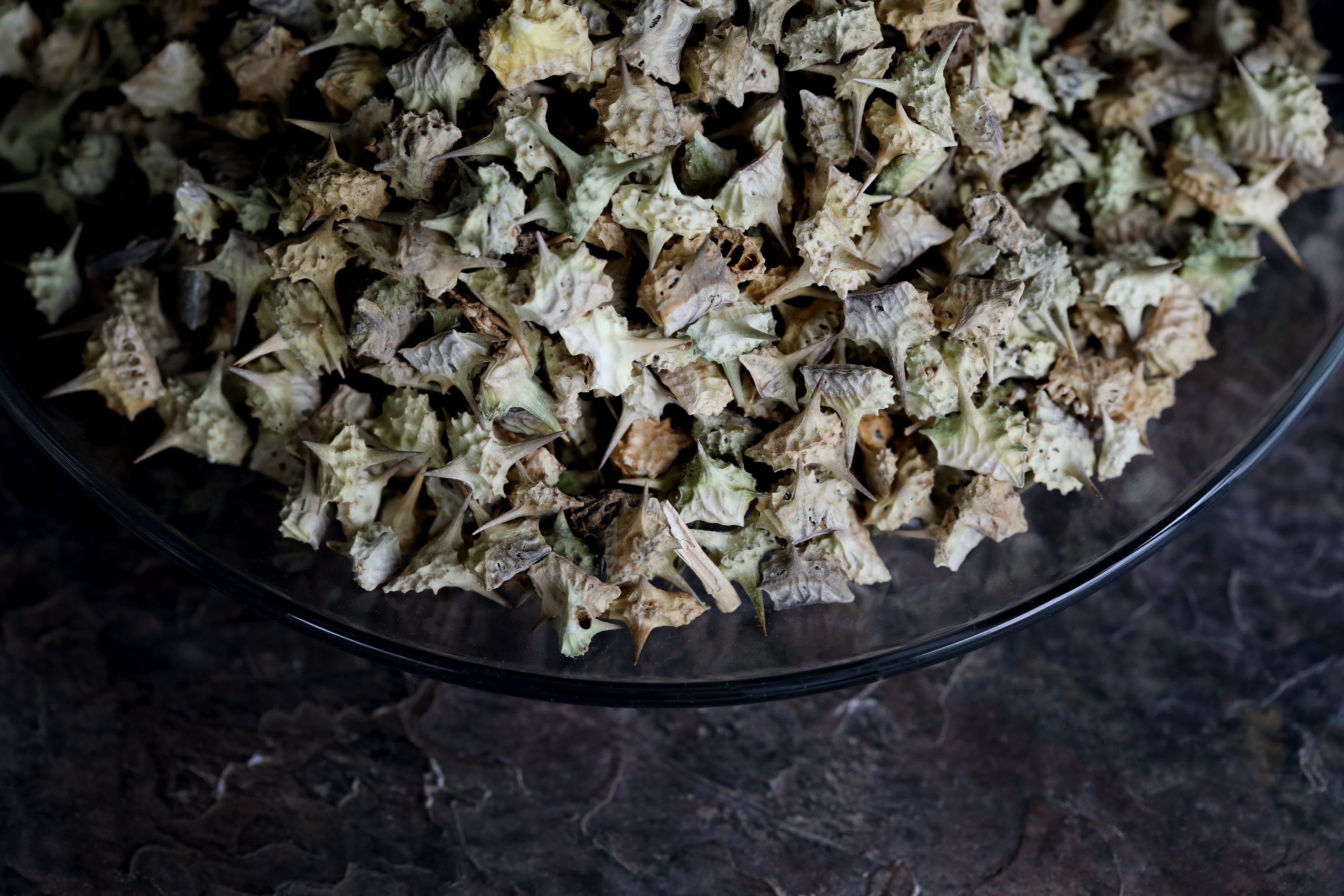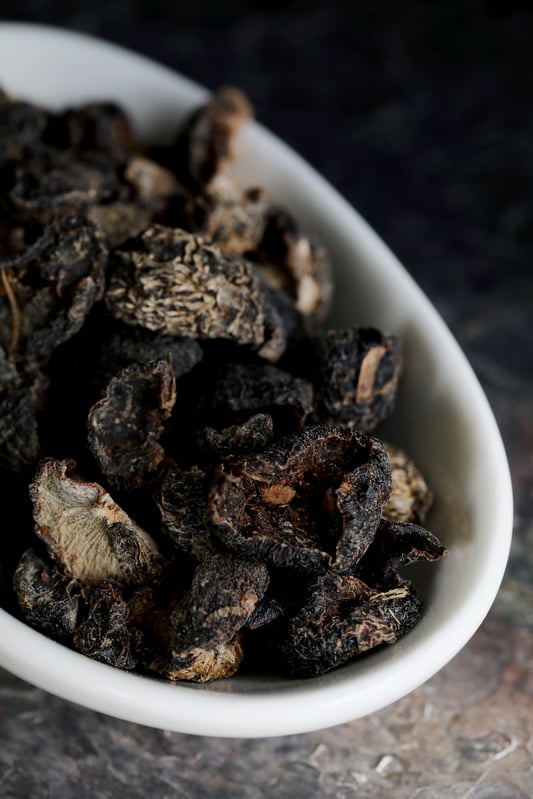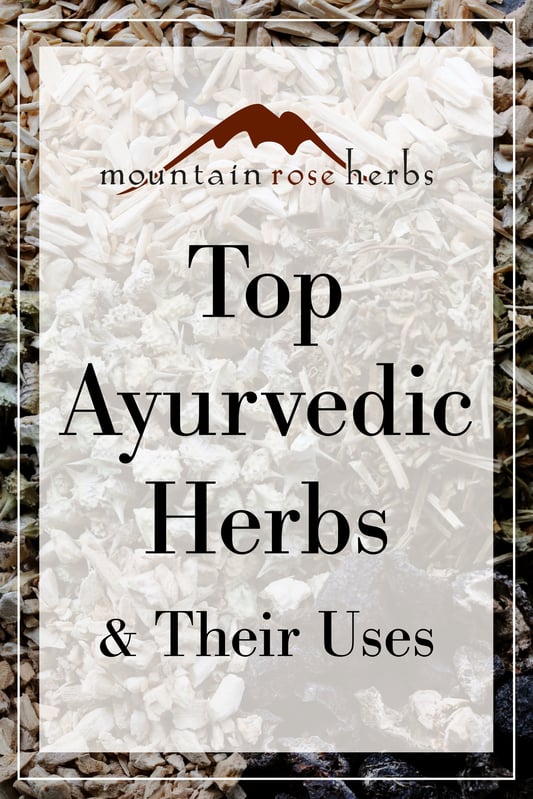Ayurveda is probably the oldest continuing health system on the planet. With a tradition going back thousands of years, Ayurveda offers a framework for understanding the body and how to best support its quest for balance. In the Ayurvedic tradition of health care, mind, body, and spirit are inextricably entwined.
Each of us is unique. But, as Yogi Berra (well, he was a sort of yogi) might say, “Some of us are more unique than others.” Ayurveda customizes each program to the individual, and at the heart of those programs are herbs. This ancient, sophisticated system relies on herbal remedies as the core health supports. Ayurveda recommends herbs in every meal, every day, for a lifetime. Some of them go in food, some support acute wellness management, and some help us maintain normal function and system balance over time.
The following seven herbs are fundamental to Ayurveda and are excellent additions to your herbal pantry.
Ashwagandha (Withania somnifera): Ashwagandha is among the most prominent tonics in the Ayurvedic pharmacopoeia, performing a role similar to that of ginseng in Traditional Chinese Medicine. Ayurveda considers this long-term building herb to be a “rasayana,” a particularly powerful rejuvenator. The name Ashwagandha means “like a horse,” connoting its traditional associations with sexual vigor (especially for men).
Ayurvedic herbalism uses ashwagandha to support healthful memory, body weight, tissues, nerves, lungs, and sleep. Modern clinicians are most likely to employ it to encourage stamina and stable mood, as well as normal cardiovascular function in combination with the famous Terminalia arjuna (arjuna bark).
Ashwagandha is known as an efficient mental rejuvenator, often used by Ayurvedic herbalists to help reestablish normal sleep rhythms and to support normal daily energy, memory, and nerve function. This tonic herb, a relative of tomatoes and potatoes, is not stimulating, but rather relaxing. Due to its mellow nature, many individuals find they can enjoy it regularly without experiencing overstimulation, making this root a superb remedy for mitigating occasional stress resulting from a period of mental and physical overexertion.
Ayurveda views ashwagandha as a “grounding” herb, one that nourishes and regulates metabolic processes and stabilizes mood, and studies support its usefulness in managing normal life stresses, particularly among aging populations.
Science has recently begun to lend support to the encouraging overall health-building potential of this valuable Ayurvedic herb. A 2015 study was conducted to examine the possible effects of ashwagandha root extract consumption on muscle mass and strength in healthy young men engaged in resistance training. The report states that Ashwagandha supplementation is associated with significant increases in muscle mass and strength and suggests that Ashwagandha supplementation may be useful in conjunction with a resistance training program.
In Ayurveda, Withania is given with pungent, heating herbs (ginger, pepper, etc.) to increase its tonic effects.
Many individuals begin to enjoy the benefits of the herb after a couple weeks of daily intake (a gram a day is common, but individuals should work with a qualified Ayurvedic healthcare practitioner to determine the ideal amount for their needs). Since ashwagandha is a slow-acting herb, you may take your daily dose at any time during the day.
Tribulus (Tribulus terrestris): Also called Gokshura, this well-known Ayurvedic herb is a highly esteemed sexual tonic and rejuvenation supplement traditionally closely associated with the urogenital tract. Ayurveda holds that tribulus promotes normal urine flow and soothes the urogenital membranes. It is also used to pacify cold and dry conditions, but lacks the tendency of many other diuretics to promote secondary excess dryness. Ayurveda makes use of tribulus for prostate support. The plant and seeds are used to support proper, comfortable urination. This herb is sometimes combined with guggul, triphala, and trikatu in a traditional Ayurvedic tridoshic compound formula called “gokshuradi guggul,” used to support the proper function of the genitourinary tract.
Tribulus also promotes normal mental function, and I have used it to encourage positive mood with apparent success. This herb contains harmine alkaloids, which may explain its sedative properties. It may be taken with ashwagandha as a tonic nervine in vata disorders.
It is sweet and cold, so it is appropriate for heat conditions.
As a tonic, it balances cold and dry energies. Enjoy as a daily tonic with honey, ghee, or milk.
Shatavari root (Asparagus racemosus): Shatavari is the main Ayurvedic rejuvenating tonic for women, often used to inspire sensual desire in the way ashwagandha is used for men (the name means “hundred husbands,” so you can take the hint). This builder and balancer for the female reproductive system is said to support normal reproductive and general hormonal wellness.
The shatavari plant is a close cousin to the asparagus we eat as a vegetable, which has similar properties.
For mothers, Ayurvedic practitioners often recommend this herb to encourage milk production, and for elders, it is considered a valuable aid in smoothing out some of the effects of the physical shifts women experience with advancing age.
According to Ayurvedic tradition, cooling and fortifying shatavari supports normal immune, cognitive, and digestive function.
Shatavari is also a demulcent, often used as a soothing treatment for dry membranes of the lungs, stomach, kidneys, and reproductive organs. It is also a mild diuretic, and as such may support normal urinary function.
Brahmi (Bacopa monneri): Brahmi (which means “godlike”, a reference to its impressive reputation for supporting longevity and mental vitality) is a steadfast mainstay of traditional Ayurveda. It is looked upon as powerful brain food, recommended in the Ayurvedic tradition as a nervine and cognitive rejuvenator. It is a favorite plant ally for those working to improve and deepen their meditation practice. Ayurvedic practitioners consider brahmi a useful aid to support comprehension, concentration, and recollection. These brain fog-clearing tendencies, in turn, may help ease normal daily stresses by facilitating more efficient problem solving.
With over 300 studies in the scientific literature, brahmi is building up a solid base of scientific support for many of its traditionally celebrated functions.
Ayurveda generally considers brahmi to be safe and effective for children, and it is commonly given to Indian schoolchildren at home. Indian scientists gave one gram of brahmi (dried plant extracted in a syrup) to 40 schoolchildren aged six to eight in a single-blind trial and recorded statistically significant performance improvements in maze learning, short-term memory, and perception. No side-effects were observed.
Amla fruit (Emblica officinalis): According to Ayurveda, the famous Indian amla fruit is considered to be one of the strongest rejuvenatives. Containing helpful antioxidants, practitioners have traditionally looked to amla to reduce tissue damage and cool overheated organs. In fact, Ayurveda considers amla to be the best single herb for excess damaging heat in the body. Even small amounts of amla are thought to noticeably offset many common complaints associated with aging.
Amla is the basis for “chyavanprash,” the most famous Ayurvedic rejuvenating jelly, a food supplement designed to support healthful reproductive, liver, and cardiovascular function. Into a base of fresh amla fruit, over two dozen other herbal ingredients are added for their synergistic effects, including ghee, sugar cane juice, honey, clove, and cinnamon. As a mild all-around health tonic, chyavanprash can be used by people of all ages for its fortifying and energizing properties, or as a general energy supplement, but Ayurveda considers it especially appropriate for men.
Chyavanprash may be enjoyed daily or periodically stirred into warm milk or spread on toast.
Arjuna (Terminalia arjuna): Ayurvedic tradition regards arjuna as a cardiovascular panacea. Arjuna’s constituents include a variety of polyphenols, which probably account for much of its activity, including tannins, ellagic acid, gallic acid, proanthocyanidinic oligomers (PCOs), and flavonoids (arjunone, arjunolone, and luteolin). It also contains triterpenoid saponins (arjunic acid, arjunolic acid, arjungenin, arjunglycosides), phytosterols, calcium, magnesium, zinc, and copper.
Arjuna is thought to encourage healthful cardiac muscle function and the pumping activity of the heart, and recent studies support arjuna's beneficial properties for supporting cardiovascular well-being
In my clinical experience, I have recommended arjuna as part of a program intended to normalize heart function.
Gotu kola (Centella asiatica): Like brahmi, gotu kola is another plant long associated with the building of the intellect. In fact, in Ayurveda, this herb is also sometimes even called “brahmi” due to its similar properties (an excellent reminder to observe scientific names in your herbal practice!). Also commonly referred to as Mandukaparni, is a mainstay of herbal medicine in Ayurveda. Traditionally considered a superior herb for the nervous system, it has a bitter taste and is cooling to the body.
Gotu kola has a host of applications in Ayurveda. Traditionally, it has been used to support memory, concentration, and stable mood.
Since gotu kola is basically a mild salad vegetable, practitioners generally consider it safe for regular use, often recommending six to ten grams daily to support long term well-being (although recommended amounts will vary by individual). It is commonly enjoyed as a simple tea infusion with honey before meditation and can also be prepared as a milk decoction (simmer in milk and strain) combined with ghee, raw sugar, and honey. Another popular formula combines equal parts of ashwagandha, tribulus, and shatavari in powder stirred into honey, or encapsulated.
We can all enjoy life at a level far beyond what most of us have learned to tolerate. Make a start toward consistent Ayurvedic lifestyle and health practices—and attain knowledge from its sister science, yoga—and life can be a whole different ballgame. Happiness, in all areas of your life, including the boardroom and bedroom, is your birthright. With five thousand years of experience in helping people stay happy, healthy, and vigorous, Ayurveda can show you the way. And a few little extra herbal supports can help!
Want More Ayurvedic Lifestyle Tips from KP Khalsa?
You Can Find Him Here!
You might also enjoy:
- Easy Ayurvedic Face Mask
- Ayurvedic Cooling Drink with Amla (Indian Gooseberry)
- Triphala: The Ayurvedic Herb Everyone Should Try!
This information is based on Ayurvedic Medicine, which often uses natural herbs and nutrients to support health. The information about these ingredients has not been evaluated or approved by the FDA, nor is it based on scientific evidence from U.S. sources. This product is intended to support general well-being and not intended to treat disease or illness. If conditions persist, please seek advice from your medical doctor.

